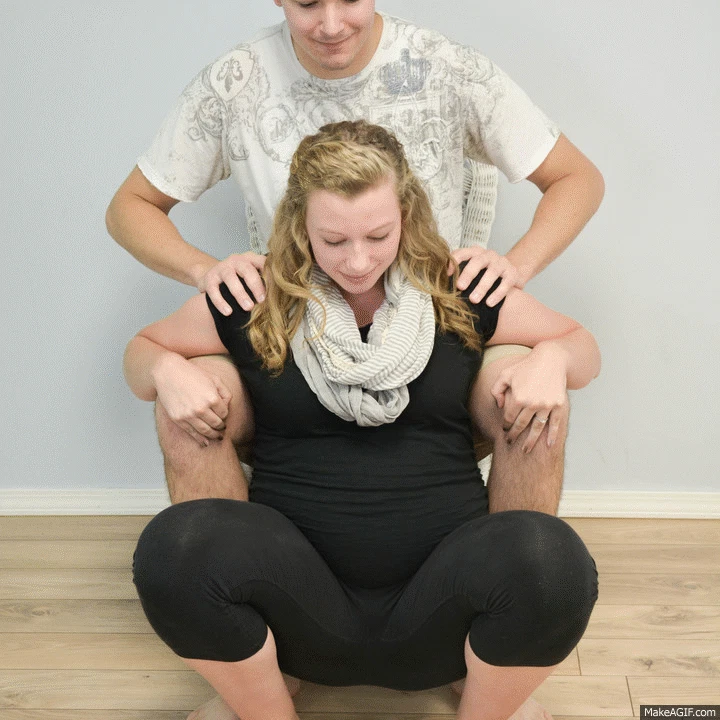9 Tips From A Birth Doula On How To Make Your Birth Experience Easier And More Comfortable
As a birth doula, I can tell you that birth is not often like the movies, which tend to make it look super dramatic, scary, and fast (like the water breaks, then it’s “Aghhhh, there’s no time – this baby is coming now!”, then some screaming, and whoosh, there’s a baby).

The birth process is usually much slower and less dramatic, although there can definitely be exceptions and emergency situations. Every woman’s birth experience is different; plenty of women have told me they felt like they were dying, while others said it was difficult but didn’t feel that same level of pain. Whichever way the labor process goes, it’s important for the expecting mother to remain as comfortable as possible (or at least try to) because the baby’s birth progress is affected by the mother’s internal environment being stimulated or calmed by her external environment.
Birthing a baby is hard work! Labor usually takes a number of hours, and some labors can be prolonged over a period of days. However long it takes, you will need all the help and comfort you can get to make the birth continue as well as possible while staying as strong as possible. This is why a doula (or a hands-on husband/midwife) is so important for a good birth experience, so you have helpful and calming support.
The following tips are meant to help you relax as much as possible while you labor, or at least feel less pain and discomfort. Besides helping you feel better, relaxing also affects birth-related hormones: calm movement and stretching positions can decrease adrenaline and cortisol levels (both of which are stimulated by stress and slow labor progress) and increase serotonin and dopamine levels (which will help the brain calm, relax your muscles and nerves, and speed up the labor progress). These options are helpful to make your labor and birth experience more comfortable and positive, and also to keep the labor progressing. It also helps if your assisting person knows these tips for labor as well.
The birth process is affected by the mother’s internal environment being stimulated or calmed by her external environment.
1. Have Your Birth Plan Already Done
Once you find out you’re expecting, it’s easy to think that you have plenty of time to get things sorted out, but those 8-9 months can go faster than you think (while maybe also sometimes feeling like they’re dragging on forever). One important thing that you can get done sooner rather than later is to make your birth plan.
Making your birth plan well ahead of time with your midwife/husband/doula will give you plenty of time to think of any additions or adjustments before the big day comes. You don’t want to think of what shots you do or don’t want your baby to get when you’re actually birthing and exhausted. If you plan on having your baby at home or in a birthing center, be sure to have a plan B thought out and even written down, in case of any emergency or medically necessary changes.
2. Practice Labor Positions
Different birth positions simply help put gravity on your side and give your body a little nudge to speed up the process, especially if your labor is slow in progressing. The key is to keep moving, even gently, while able. These techniques can also be incorporated into a daily exercise routine if you go past the due date and you’re getting impatient to meet your little person. If you’re trying to get pregnant or in the early stages of pregnancy, start squatting now!
Hands and knees: Getting down on your hands and knees and leaning to each side and forward/backward helps give relief to the legs while using gravity to support and continue the baby’s progress down the birth canal.
Down dog: Kneeling on the ground (or bed), go to your hands and knees, then slowly bring your head down to rest on your folded forearms, leaving your legs kneeling and bottom up.
Kneeling with the birthing ball: Whoever invented these birthing balls was a genius! Using a big yoga/birthing ball to sit on to widen your hips is a well-known technique, but during the actual labor, you can kneel and lean on the ball (hug it or rest your head on your forearms). Tip: Get a peanut ball or thick pillow to wedge between your knees/legs while you lie on your side for some relaxing relief for your legs and hips.
Lunging: Side lunging is sometimes easier to hold, but forward lunging is also beneficial; rock side-to-side.
Walking leaning: Lean on your partner or doula for support to rock while standing up.
Squatting: It doesn’t need to be very low; hold on to someone or something for support.

3. Practice Hypnobirthing
They often say pain is mental, right? That’s true because all your nerves and sensory receptors have to go through the brain at some point – getting reaction permission from the brain, so to speak – so methods for getting better control over your brain’s focus can help with pain management. Hypnobirthing is one such method, and it was basically invented when deep breathing and meditation had a baby. Although it’s a newer laboring technique, it has reaped amazing results! Celebrities like Angelina Jolie, Jessica Alba, and Kate Middleton championed hypnobirthing for their birth experiences. Princess Kate shared that because of hypnobirthing, she “quite liked labor!”
This technique involves deep breathing, peaceful meditation, and mindful visualization practices; it’s all about you trying to control your mental focus toward your birthing mission and labor progress. The visualization and meditation help with distracting your brain from your negative pain and onto thoughts of peaceful nature, happy memories, prayer, your arriving baby, or whatever you choose to think of! With its controlled breathing techniques, hypnobirthing has been called the most powerful tool in drug-free pain relief. You can find more on how hypnobirthing works and an available course here, or check out some free hypnobirthing videos on YouTube.

4. Playlist Your Favorite Spa Music
Music therapy is definitely a thing. When you want to just tune out of the present and distract your brain, calming music is the way to go. There are a ton of different types of spa music. Artists with soothing voices and peaceful music (one of my favorites is Enya) and nature sounds and water music are all very relaxing and comforting. Maybe have a few different options ready in case your mood changes while you’re laboring.
5. Physical Comfort Measures
Use physical comfort measures to decrease the sensation of pain and relax the nerves and muscles; this will also decrease stress hormone levels and eventually stimulate better labor progress. Thermotherapy is a great comfort measure, especially during labor for tense or painful areas. Keep cold packs and heating pads available, and maybe take a warm bath or shower (warm-hot enough to be relaxing but just not so hot that it’ll raise your blood pressure or make you light-headed). One of my birth clients told me that with her previous birth, she just wanted to be left alone and in the shower – maybe that’s you too!
Use a Tens therapy machine (a small, handheld device that’s safe for labor) to distract yourself from the pain of labor contractions. You can buy a Tens unit on Amazon here.
Or try a prenatal massage! Massage always feels good, and a specific prenatal massage stimulates the blood flow and encourages the baby’s progress down the birth canal. It uses certain pressure points to release endorphins, the feel-good hormones, which help keep the muscles relaxed and decrease your overall stress levels (and pain).
6. Essential Oils Diffuser
Using a diffuser to steam essential oils and relaxing smells into the air can do wonders to make a peaceful environment. Essential oils also have medicinal benefits, and certain EO scents are very helpful for labor to calm your nerves and help manage pain. These essential oils include lavender, frankincense, peppermint, jasmine, clary sage, rose, mandarin or lime, myrrh, and sweet orange.
Use physical comfort measures like a warm bath to decrease the sensation of pain and relax.
7. Eat Protein
Try to keep regulated with substantial meals around your due date, so that if you suddenly go into labor, then you at least have good nutrition in your system. Have healthy, more calorie-dense protein snacks available for when you’re in labor because you’re going to be burning a lot of calories to birth your baby! When you’re laboring, try to eat those nutritious protein snacks to keep up your strength.
8. Natural Labor Stimulants
Take (safe) natural remedies to speed up birth if your labor drags on, such as pregnancy tea and castor oil. Drinking raspberry leaf tea around the time of your due date may help to stimulate birth contractions, and sipping the tea during labor may help to speed up the process a bit. Though it’s not a medically prescribed substance, raspberry leaf tea is a natural stimulant for labor and has been used by pregnant women for centuries with sizeable success. Taking castor oil can also help speed up the birthing process. Warning: Do not take before 40-41 weeks of pregnancy, as it may induce early labor.
9. Get Some Love from Your Man!
There’s a birth joke that says, “What gets the baby in, gets the baby out.” While you don’t necessarily need to have sex, sexual stimulations do release those feel-good endorphin/oxytocin hormones which help speed up the labor to delivery. Kissing, nipple stimulation, a hubby massage, and even eye contact can all achieve this.
Closing Thoughts
Birthing has been successfully done since the beginning of human creation, and the human body is wonderfully capable of performing this amazing event. Of course, it’s very natural to think of things that could go wrong, but it’s more important to think positively and focus on what you can do right to help your birth go as smoothly as possible.
Don’t miss anything! Sign up for our weekly newsletter and get curated content weekly!